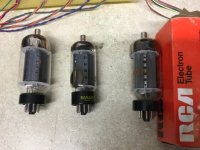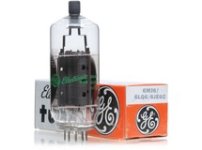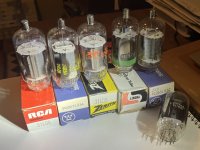The GE data sheet for the 6LQ6 describes it as a "double-ended high perveance beam power pentode". I am puzzled by the term "double-ended". Could anyone shed light on it in relation to this valve? And are there other valves also described as "double-ended"?

Plate cap on top. Single-ended horizontal outputs (there were a few) had only base terminals and of course lower voltage limits.
Most top-cap-type horizontal outputs are NOT described as “double ended”. There are some that have double plate structures (and others that have two complete pentodes in them). The one on the right has two complete plates - one on either side of the beam former. Both connect to the top cap. That could be what they are referring to.
Attachments
Anyone have a picture of an LQ6? I have traditionally avoided Novars because of socket difficulties, so most of my stash is 12 pin compactron and octal.
I’ve got piles of them but I’m at work atm. Many of the illegal CB linear amps used them.
https://www.ebay.com/itm/3868076260...mO6m1wXTKC&var=&widget_ver=artemis&media=COPY
https://www.ebay.com/itm/3868076260...mO6m1wXTKC&var=&widget_ver=artemis&media=COPY
The 6LQ6 is identical to the 6JE6C. The 6LQ6 type number is reserved for the 30 watt plate version and used to prevent people from putting 6JE6's or 6JE6A's into TV sets that needed the 6JE6C. This is similar to the 6FW5 which is a 6AV5GA only. Again, a 6AV5 or 6AV5GTwould have a short unhappy life in a 6AV5GA socket.
The common data sheet also 30 watts of plate current. Probably a poor translation from Japanese.
The common data sheet also 30 watts of plate current. Probably a poor translation from Japanese.
Then “double ended” may be a poor translation from Japanese as well. I don’t see anything that one that is fundamentally different from my stash of 21LG6’s, or others (lower rated, lower heater current) that share that plate. A couple of those have bigger fins, but the one on the far right doesn’t. There is only one plate and one connection to it. If it simply means “top cap type”, so what? That’s the rule, not the exception. You have to go out of your way to get types that don’t have a top cap.The common data sheet also 30 watts of plate current. Probably a poor translation from Japanese.
I've always seen "double ended" in old texts referring to tubes with connections at both ends. Caps or pin(s) on the top end typically. Probably some old timer wrote up the 6LQ6 datasheet.
Here is a tube that is un-mistake-ably "double ended" in spades, with tube pins for sockets at both ends. It's a Tektronix "scan converter" tube. Has a high speed CRT on one end, a silicon storage target screen in between, and a camera tube on the other end for readout. Were used for making multi-GHZ analog scopes at one time. (Tek R7912A was one such scope)
https://www.ebay.com/itm/364560663728
Here is a tube that is un-mistake-ably "double ended" in spades, with tube pins for sockets at both ends. It's a Tektronix "scan converter" tube. Has a high speed CRT on one end, a silicon storage target screen in between, and a camera tube on the other end for readout. Were used for making multi-GHZ analog scopes at one time. (Tek R7912A was one such scope)
https://www.ebay.com/itm/364560663728
The Lindal packaging dates from the period during which Lindal (a re-seller) mimicked the packaging of ITT. There is a nice YouTube clip explaining the whys and wherefores Lindal's marketing:
If you want a 6LQ6, use 6ME6 that are only $30 vs 6LQ6 $45 at vacuumtubes.net. Same tube as 6LQ6
- Home
- Amplifiers
- Tubes / Valves
- 6LQ6 GE data sheet - assistance with interpreting the description


